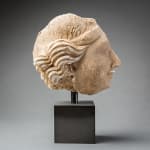Gandharan Sculpture of a Male Head, 100 CE - 500 CE
Stucco
height 15.2 cm
height 6 in
height 6 in
LO.1058
Further images
Stucco sculpture of a man's head captured in a gentle open smile, with a rather imposing protruding nose, the eyes almond-modelled, his wavy long hair tied up with a band...
Stucco sculpture of a man's head captured in a gentle open smile, with a rather imposing protruding nose, the eyes almond-modelled, his wavy long hair tied up with a band in the front. Though part of his head is missing, his expression is captured fully; its refined style greatly demonstrating the incredible visual and sculptural skills of the ancient Gandharan artists.
The Gandhara region had long been a crossroads of cultural influences. Geographically it included roughly northwestern India between the Khyber Pass and the Indus River and the region of the Kabul Valley in Afghanistan. During the reign of the Indian emperor Ashoka around 3rd century B.C., the region became the scene of intensive Buddhist missionary activity; and, in the 1st century AD, rulers of the Kushan empire such as Kanishka (AD 129-160) maintained contacts with Rome and employed foreign artists from the eastern centres of the Roman Empire to realise many sculptural works. The many archaeological discoveries of Alexandrian and Syrian workmanship at Taxila in the Punjab and Begram in the Kabul valley testify to the cultural and diplomatic connections with the Graeco-Roman West. Many artifacts, in particular sculptures, have survived and are now dispersed in major museums throughout the world.
Originally this head -possibly portraying either a Buddhist donor or a devotee- would have been covered with brilliant pigments and placed in a larger narrative scene. His original role is now lost forever, yet his exuberant smile and inner spirit transcended time and are still perceivable nowadays.
The Gandhara region had long been a crossroads of cultural influences. Geographically it included roughly northwestern India between the Khyber Pass and the Indus River and the region of the Kabul Valley in Afghanistan. During the reign of the Indian emperor Ashoka around 3rd century B.C., the region became the scene of intensive Buddhist missionary activity; and, in the 1st century AD, rulers of the Kushan empire such as Kanishka (AD 129-160) maintained contacts with Rome and employed foreign artists from the eastern centres of the Roman Empire to realise many sculptural works. The many archaeological discoveries of Alexandrian and Syrian workmanship at Taxila in the Punjab and Begram in the Kabul valley testify to the cultural and diplomatic connections with the Graeco-Roman West. Many artifacts, in particular sculptures, have survived and are now dispersed in major museums throughout the world.
Originally this head -possibly portraying either a Buddhist donor or a devotee- would have been covered with brilliant pigments and placed in a larger narrative scene. His original role is now lost forever, yet his exuberant smile and inner spirit transcended time and are still perceivable nowadays.







